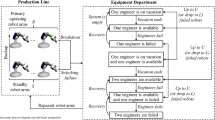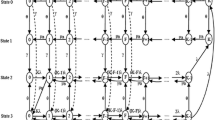Abstract
This article analyzes the maintenance of production system with unreliable machines. This system includes a repair facility and three types of “unreliable” machines: the main facility of working and reserve machines, and an auxiliary facility of “super-reserve” machines. Operating times of working machines are exponentially distributed. Upon failure, a working machine is immediately replaced by reserve machines available. Defective machines line up for repair, whose duration is arbitrarily distributed. Refurbished machines return to the main facility. If the main facility is restored to its original quantity (i.e., all machines are intact), the repair facility leaves on routine maintenance; all w+1 reserve machines are temporarily blocked and renewals come from the super-reserve group until the latter becomes exhausted. Then, the busy period is regenerated. The techniques include two-variate Markov and semi-regenerative processes, and a duality principle, to find the probability distribution of the number of intact machines. Explicit formulas obtained demonstrate a relatively effortless use of functionals of the main stochastic characteristics (such as expenses due to repair, maintenance, waiting, and rewards for higher reliability) and optimization of their objective function. Applications of such models include computer networking, human resources, and manufacturing processes.
Similar content being viewed by others
References
E. Çinlar, Introduction to Stochastic Processes, Prentice Hall: Englewood Cliffs, N.J., 1975.
J. H. Dshalalow, “On the multiserver queue with finite waiting room and controlled input,” Adv. Appl. Prob. vol 17 pp. 408—423, 1985.
J. H. Dshalalow, “On a duality principle in processes of servicing machines with double control,” J. of Appl. Math. & Sim. vol. 1(3) pp. 245—251, 1988.
J. H. Dshalalow, “On single-server closed queues with priorities and state dependent parameters,” Queueing Systems vol. 8 pp. 237—254, 1991.
J. H. Dshalalow, “Queueing systems with state dependent parameters,” in Frontiers in Queueing, edited by J. H. Dshalalow, CRC Press: Boca Raton, FL, pp. 61—116, 1997.
T. S. S. Srinivasa Rao and U. C. Gupta, “Performance modelling of the M/G/1 machine repairman problem with cold-, warm-and hot-standbys,” Computers and Ind. Engineering vol. 38 pp. 251—267, 2000.
L. Takács, Introduction to the Theory of Queues, Oxford University Press: New York, NY, 1962.
L. Takács, “Some probability questions in the theory oftelephone traffic,” Mag. Tud. Acad. Mat. Fiz. Oszl. Köiz. pp. 155—175, 1958.
Author information
Authors and Affiliations
Rights and permissions
About this article
Cite this article
Kim, SK., Dshalalow, J.H. A Versatile Stochastic Maintenance Model with Reserve and Super-Reserve Machines. Methodology and Computing in Applied Probability 5, 59–84 (2003). https://doi.org/10.1023/A:1024177304981
Issue Date:
DOI: https://doi.org/10.1023/A:1024177304981




